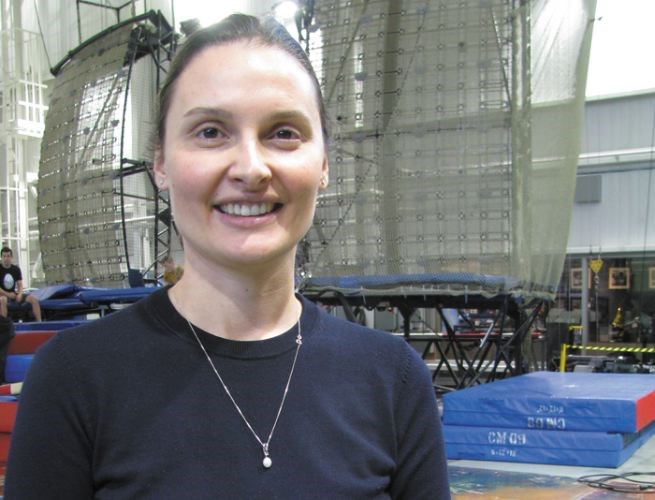Cirque du Soleil is in Prince George today with one of their most unique productions in a history built on unique productions.
The show Crystal opens tonight for a run of seven shows between now and Sunday. But where did they come from?
The cast is based on the world's best acrobatic athletes in their field.
It has spawned a word particular to Cirque: acrothletes.
And this time, you can also add ice to the degrees of difficulty. They are performance athletes, they are acrobats, they are skaters.
One of the chief directors of the casting process, Stacy Clark, told The Citizen that the producers had to discover new hotbeds of talent than when they go looking for their usual circus arts professionals.
"It has its nations that are stronger. That's one of our learnings in casting, is finding where there is talent and interest and volume - enough pickings to get the best of the best. And we do try to cast a wide net," Clark said.
Some Cirque casts have as many as 45 nations represented, and Crystal has 14, partly due to the concentration of skating talent in North America, Europe and a few Asian countries. But no cast member is ever turned away due to the colour of their flag.
Circus as an historic art form has always been a champion of inclusion. In fact, inclusion has even been exploited in the circus acts of yore, with disfigurements and freakish traits leveraged for money.
Cirque du Soleil has never strayed from its true-blue circus beginnings, when some buskers were hired in Quebec to do a custom production in the early 1980s. That show was a hit, that association of street performers had momentum, and Cirque was born.
Today, it is as close to its original roots as an epic multinational corporate empire can be. Global tours, global scouting, more installed shows in Vegas alone than you can count on one hand, plus the installation shows in other countries... Cirque is one of the world's great forces in entertainment.
Yet, their address is still in the St. Michel district of Montreal where it all began. It's just housed in a state of the art complex the size of some subdivisions.
"This is one of the poorest neighbourhoods in Canada," said performer-turned-spokesperson Frdrique Gagnier, leading the tour of the massive and busy facility.
"Because we started as street performers, it was really important at the beginning to headquarter here and be very close to this artists' district. It absolutely has an economic effect on this neighbourhood. We employ a lot of people from the neighbourhood and there is a lot of spinoff. We are 4,000 employees total. We are all over the world, but 1,500 of us are here in St. Michel."
The dominant room in the Cirque headquarters is acro training space Studio A/B, with its 23-meter span from floor to ceiling.
"We can bring the whole show into this one spot and rehearse it all from beginning to end," said Gagnier, opening the doors to some other studios that do similar things. Some are loaded in gymnastics equipment. Some have walls of interior windows so production staff can watch from attached offices.
All the spaces, even the stairwells and lunch rooms, are designed to spark the creative mind.
No wall lacks art, the front lawns are a garden of sculptures, and the lobby features a trophy case that can't help but draw the eye to the Emmy Awards alongside the other international accolades they have earned over their years.
"About a third of the artists come from a sports background, usually from gymnastics, but more and more from mixed disciplines like BMX riders or for Crystal the inline hockey player and the Crashed Ice competitors and figure skaters," Gagnier said.
"Another third comes from a circus background, and from all over the world in that sense.
The other third are musicians and actors and performers from the artistic sides of the performance world.
"It is not always the gold medallist who makes the best performer," she added.
"We need the athletic abilities but we also need the performance abilities to come through. This isn't for a panel of judges, it is for an audience looking for entertainment, which is much, much different than achieving technical scores or scoring a goal."
There are also the technical rooms loaded like NASA control centres with the technological machinery of sound and light, so that backstage side of all Cirque shows can also be designed, rehearsed and the technicians trained.
More than any other show save for the swimming extravaganza O, Crystal represented a show beyond the capabilities of Cirque's design headquarters.
They had to go off-site for major components of the preparations of this venture.
"We have this gigantic training space with all of our technicians, all of our experts, all of our equipment at our fingertips, but then all of a sudden we have to go rent an ice rink, which by the way is very hard to do in the winter in Quebec," said Clark.
"There were all the logistics of getting all the ramps and crash mats over there and set up every time. Because unlike figure skaters who strap on their skates and go, we actually need to ship all this stuff over there all the time. As compared to walking into the studio every day where you have everything you want. And it's warm. Ice rinks are freezing."
Gagnier said they actually attempted to do the ice in Studio A/B but it wasn't as sensible as just moving temporarily into a local rink.
Now the show is moving into ours, for the next five days. To see the show that even challenged the resources of Cirque du Soleil, come to CN Centre starting tonight to see Crystal.



